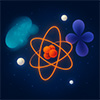| Jul 30, 2025 |
Quantum chemistry is helping scientists understand why some chemical reactions succeed while others fail, by showing how the movement of electrons affects each step.
(Nanowerk News) Chemical research is often a process of trial and error. Things often don’t go as expected in the laboratory: reactions stall or produce too little product. Knowledge of the chemical properties of the substances involved is then no longer sufficient. Instead, chemists would like to “look deeper” into the reaction, down to the subatomic level. This is possible with high-tech analytics. And quantum chemistry is also increasingly in demand, as it can reveal critical moments in the catalytic process solely through calculation, e.g., of the behavior of electrons. Dr. Olga Bokareva heads this work at LIKAT in Rostock. A current example is a novel Diels-Alder reaction.
|
|
Increasing computing power and ever-improving algorithms have made the modeling of chemical reactions indispensable in research. “This is particularly true where chemistry is breaking new ground, for example in replacing fossil raw materials with by-products of civilization. Or in expanding the range of applications for classic and proven processes and using them for sustainable processes,” says Olga Bokareva, head of a junior research group at the Leibniz Institute for Catalysis.
|
Diels-Alder reloaded: more effective with electricity
|
|
The chemist cites the Diels-Alder reaction as a current example. For three quarters of a century, it has had a firm place in organic chemistry, especially in the synthesis of active pharmaceutical ingredients and other complex molecules. Its discoverers were awarded the Nobel Prize in 1950.
|
|
Several laboratories are currently attempting to make the Diels-Alder reaction usable for far more complex syntheses than has been possible to date. At LIKAT, this has been achieved by electrochemical means. Dr. Bokareva explains: “Electrodes in the reaction solution provide a current that drives the process and makes it much more effective than the classic Diels-Alder reaction.”
|
|
Scientific Director of LIKAT, Prof. Dr. Robert Franke, collaborated with colleagues from Japan on this project, and together they submitted a paper (Catalysis Science & Technology, “Controlling the reactivity of enol ether radical cations <i>via</i> the substitution pattern: investigation into electrochemically induced Diels–Alder reactions”). Their experiments had shown that the electrochemical Diels-Alder reaction works wonderfully with certain starting materials, but not at all with others. The authors offered some hypotheses as to the causes. However, the journal requested a detailed mechanistic explanation using quantum chemical methods.
|
|
This is where the expertise of Dr. Bokareva and her team came into play. A doctoral student, Yanan Han, took on the work as part of her dissertation.
|
Comparable to Google Maps
|
|
To understand the reaction mechanism, the team used quantum chemistry to calculate the energy of the molecules along the reaction pathway. All they needed to know was the starting material and the product, as well as some information about the reaction conditions, such as the temperature. Dr. Bokareva compares this approach to Google Maps: “You know your location and destination and want to avoid traffic jams; in the reaction, this could be an undesirable intermediate product. The program calculates the best route.”
|
|
Such quantum chemical calculations do not provide exact values, but rather approximations, Dr. Bokareva explains. The current state of individual molecules is determined by the difference between their energy states. The reason for this lies in the quantum nature of electrons, which are described by wave functions.
|
|
The mathematical foundations for such calculations were developed around a hundred years ago, such as the Schrödinger equations, which Olga Bokareva and her team use together with numerical methods.
|
Electron clouds determine the reaction
|
|
Today, the results can be represented graphically, for example as orbitals, which is the name given to the locations of electrons in atoms. On the screen, they appear as colored structures reminiscent of floating balloons. “We often talk about electron clouds when we mean the diffuse space where electrons are located,” says Olga Bokareva. Such representations help not only to analyze reaction processes, but also to understand them intuitively. “Quantum chemistry is not only challenging, it is also beautiful.”
|
|
What did the calculations for the novel Diels-Alder reaction show? “We were able to identify an intermediate product that is formed at a critical moment in the process,” says Dr. Bokareva. For the reaction to continue, this intermediate product needs an additional electron. The system must allow this electron transfer to occur energetically, and the researchers were able to identify specific conditions for this in the behavior of the electron clouds. These conditions were not met in the problematic substrates, and the reaction broke down.
|
|
The reason for the disruption has therefore been found, and the findings have now been published jointly with partners from Japan and recently appeared online. According to Dr. Bokareva, the work offers approaches for making substrates that have not been successful to date usable for electrochemical Diels-Alder synthesis. For example, by changing the electronic structure of these compounds or the electrochemical reaction conditions.
|
No longer a male domain
|
|
It may sound surprising that this insight was gained through theoretical work. For Olga Bokareva, it is a matter of course to use pure calculation and “genuine teamwork to shed light on puzzling experimental findings and reveal hidden mechanisms.” This fulfills her more than the work she did in the laboratory many years ago.
|
|
Olga Bokareva earned her doctorate and habilitated—both in theory and quantum chemistry, fields that were long dominated by men. This is one of the reasons why she is proud that four of her doctoral students are women. Her group is growing steadily and is working on current issues at the interface between theory and application.
|

